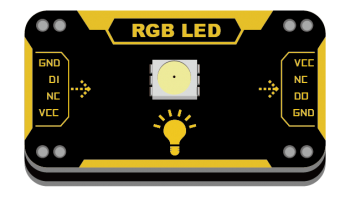RGB LED
来自Labplus盛思维基百科
概述
采用LED专用主控芯片WS2812,支持单总线控制,仅需一根管脚即可控制所有LED,并且模块支持级联控制,可以多个模块同时控制,不占用管脚资源。可实现256级亮度显示,16777216种颜色的全真色彩显示颜色。
技术参数
- 工作电压:3.3Vor5V
- 通讯方式:单总线控制
- 功 率:0.3W/颗
- 灰度等级:256级
- 16777216种颜色的全真色彩
- 支持级联控制
- 模块尺寸:24x46x7.5mm
引脚定义
| VCC | 电源 |
| NC | 空脚 |
| DI | 控制数据信号输入 |
| GND | 地 |
| VCC | 电源 |
| NC | 空脚 |
| DO | 控制数据信号输出 |
| GND | 地 |
当多个模块需要级联时,把上一个模块的DO连接至下个模块的DI!
使用教程
连接示意图
Arduino示例
Arduino库 Adafruit NeoPixel 点击下载
// This is a demonstration on how to use an input device to trigger changes on your neo pixels.
// You should wire a momentary push button to connect from ground to a digital IO pin. When you
// press the button it will change to a new pixel animation. Note that you need to press the
// button once to start the first animation!
#include "Adafruit_NeoPixel.h"
#define PIXEL_PIN 7 // Digital IO pin connected to the NeoPixels.
#define PIXEL_COUNT 10 //级联数量
// Parameter 1 = number of pixels in strip, neopixel stick has 8
// Parameter 2 = pin number (most are valid)
// Parameter 3 = pixel type flags, add together as needed:
// NEO_RGB Pixels are wired for RGB bitstream
// NEO_GRB Pixels are wired for GRB bitstream, correct for neopixel stick
// NEO_KHZ400 400 KHz bitstream (e.g. FLORA pixels)
// NEO_KHZ800 800 KHz bitstream (e.g. High Density LED strip), correct for neopixel stick
Adafruit_NeoPixel strip = Adafruit_NeoPixel(PIXEL_COUNT, PIXEL_PIN, NEO_GRB + NEO_KHZ800);
void setup() {
strip.setBrightness(50); //调亮度
strip.begin();
strip.show(); // Initialize all pixels to 'off'
}
void loop() {
for(uint16_t num1=0;num1<PIXEL_COUNT;num1++)
{
strip.setPixelColor(num1,255,0,0); //设置红色
}
strip.show(); //显示
delay(500);
for(uint16_t num1=0;num1<PIXEL_COUNT;num1++)
{
strip.setPixelColor(num1,0,255,0); //设置绿色
}
strip.show(); //显示
delay(500);
for(uint16_t num1=0;num1<PIXEL_COUNT;num1++)
{
strip.setPixelColor(num1,0,0,255); //设置蓝色
}
strip.show(); //显示
delay(500);
//rainbow(10);
//rainbowCycle(8);
//theaterChaseRainbow(100);
}
void startShow(int i) {
switch(i){
case 0: colorWipe(strip.Color(0, 0, 0), 50); // Black/off
break;
case 1: colorWipe(strip.Color(255, 0, 0), 50); // Red
break;
case 2: colorWipe(strip.Color(0, 255, 0), 50); // Green
break;
case 3: colorWipe(strip.Color(0, 0, 255), 50); // Blue
break;
case 4: theaterChase(strip.Color(127, 127, 127), 50); // White
break;
case 5: theaterChase(strip.Color(127, 0, 0), 50); // Red
break;
case 6: theaterChase(strip.Color( 0, 0, 127), 50); // Blue
break;
case 7: rainbow(20);
break;
case 8: rainbowCycle(20);
break;
case 9: theaterChaseRainbow(50);
break;
}
}
// Fill the dots one after the other with a color
void colorWipe(uint32_t c, uint8_t wait) {
for(uint16_t i=0; i<strip.numPixels(); i++) {
strip.setPixelColor(i, c);
strip.show();
delay(wait);
}
}
void rainbow(uint8_t wait) {
uint16_t i, j;
for(j=0; j<256; j++) {
for(i=0; i<strip.numPixels(); i++) {
strip.setPixelColor(i, Wheel((i+j) & 255));
}
strip.show();
delay(wait);
}
}
// Slightly different, this makes the rainbow equally distributed throughout
void rainbowCycle(uint8_t wait) {
uint16_t i, j;
for(j=0; j<256*5; j++) { // 5 cycles of all colors on wheel
for(i=0; i< strip.numPixels(); i++) {
strip.setPixelColor(i, Wheel(((i * 256 / strip.numPixels()) + j) & 255));
}
strip.show();
delay(wait);
}
}
//Theatre-style crawling lights.
void theaterChase(uint32_t c, uint8_t wait) {
for (int j=0; j<10; j++) { //do 10 cycles of chasing
for (int q=0; q < 3; q++) {
for (int i=0; i < strip.numPixels(); i=i+3) {
strip.setPixelColor(i+q, c); //turn every third pixel on
}
strip.show();
delay(wait);
for (int i=0; i < strip.numPixels(); i=i+3) {
strip.setPixelColor(i+q, 0); //turn every third pixel off
}
}
}
}
//Theatre-style crawling lights with rainbow effect
void theaterChaseRainbow(uint8_t wait) {
for (int j=0; j < 256; j++) { // cycle all 256 colors in the wheel
for (int q=0; q < 3; q++) {
for (int i=0; i < strip.numPixels(); i=i+3) {
strip.setPixelColor(i+q, Wheel( (i+j) % 255)); //turn every third pixel on
}
strip.show();
delay(wait);
for (int i=0; i < strip.numPixels(); i=i+3) {
strip.setPixelColor(i+q, 0); //turn every third pixel off
}
}
}
}
// Input a value 0 to 255 to get a color value.
// The colours are a transition r - g - b - back to r.
uint32_t Wheel(byte WheelPos) {
WheelPos = 255 - WheelPos;
if(WheelPos < 85) {
return strip.Color(255 - WheelPos * 3, 0, WheelPos * 3);
}
if(WheelPos < 170) {
WheelPos -= 85;
return strip.Color(0, WheelPos * 3, 255 - WheelPos * 3);
}
WheelPos -= 170;
return strip.Color(WheelPos * 3, 255 - WheelPos * 3, 0);
}
MicroPython示例
from microbit import *
import neopixel
import math
display.off()
np=neopixel.NeoPixel(pin0,4) #pin0为控制引脚,级联4个RGB
while True:
for i in range(4):
np[i]= (255,0,0) #设置4颗灯珠显示颜色,颜色为红
np.show() #刷新显示颜色
for i in range(4):
np[i]= (0,255,0) #设置4颗灯珠显示颜色,颜色为绿
sleep(1000)
np.show() #刷新显示颜色
for i in range(4):
np[i]= (0,0,255) #设置4颗灯珠显示颜色,颜色为蓝
sleep(1000)
np.show() #刷新显示颜色
sleep(1000)
